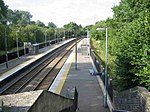Newgate Street, Hertfordshire

Newgate Street is a village near Cuffley, in Hatfield civil parish, in the Hertsmere district of Hertfordshire, England. It is approximately six miles south-west of Hertford and has a population of 400. At the 2011 Census the population was included in the town of Hatfield. The village has an Anglican church, a school (Ponsbourne St Mary's), a restaurant (The Gables), two pubs (The Crown and The Coach and Horses) and a hotel (Ponsbourne Park Hotel). There is also a small town hall and two outdoor tennis courts. Originally in the Manor of Tolmers, the present Tolmers Park House dates from 1761. Since World War I it has been used as a military hospital, a girls' boarding school, a geriatric hospital and has now been converted to luxury apartments. Part of the estate became Tolmers Scout Camp in 1940. The house lies just to the South-West of the village.
Excerpt from the Wikipedia article Newgate Street, Hertfordshire (License: CC BY-SA 3.0, Authors, Images).Newgate Street, Hertfordshire
Newgate Street Village, Welwyn Hatfield
Geographical coordinates (GPS) Address Nearby Places Show on map
Geographical coordinates (GPS)
| Latitude | Longitude |
|---|---|
| N 51.728574 ° | E -0.116405 ° |
Address
Newgate Street Village
Newgate Street Village
SG13 8RP Welwyn Hatfield
England, United Kingdom
Open on Google Maps











